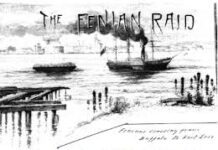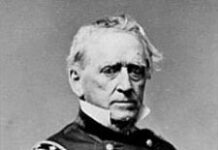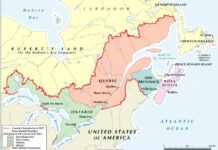The years surrounding Confederation in Canada were ones dominated by a menace, a threat to safety and security among all the people of what is now called Ontario, then Canada West. The American Civil War had left some very strong anti-British feeling in the victorious Northern States, feelings which were easily transferred to the British colonies just over the border to the north. Although the immediate fear of an invasion by the Americans quickly dissipated, another, equally fearsome threat soon arose: the Fenians.
The Fenian Brotherhood was an Irish-American Republican movement of Civil War veterans and others, tens of thousands of men who had experience of warfare and were disciplined, trained and armed. Their belief that they held the power to wrest Ireland away from British rule was held in check only by the existence of the Royal Navy, and the Atlantic Ocean on which it sailed. But the idea took hold that, if Ireland itself was difficult to reach, the Canadian colonies were not, and might be used as a bargaining chip in forcing redress of Irish grievances.
The first months of 1866 witnessed increasing tension on both sides of the border, as the Fenians marched, raised huge sums of money to finance their plans, and openly boasted that Canada would experience their wrath within months. It was generally assumed that an invasion could be expected around the symbolic date of March 17, St. Patrick’s Day. The crisis was given added vigour when the British Government suspended Habeas Corpus in Ireland.
All of this was being watched with grave concern in this region. A militia company had been organised in the Kemptville area during the Civil War, with its Drill Shed located at Millar’s Corners, under the command of John Johnston. In 1866, Ambrose Clothier was the Company Captain. Another company was formed in Burritts Rapids, led in 1866 by George Shepherd, the Lockmaster in the village. It mustered a Captain, Lieutenant, Ensign, Colour Sergeant, two regular Sergeants, three Corporals, thirty-six Privates and a Bugler, Alfred Young. There were four Actons and three Weedmarks, and many other familiar family names appear on the rolls.
As Fenian threats and dithering American Government responses increased the pressure on the Canadian Government, John A. Macdonald (not yet a “Sir”), called out 10,000 militia volunteers for active service. It is unclear whether the Kemptville Company was active at this point, as only the Burritts Rapids Company are recorded as answering the call to arms, and one Kemptville resident, William Dickinson, is listed as marching with them.
The men gathered at Richard Guest’s tannery at the corner of Centre and Henry Streets on March 10, 1866, with full equipment and ready to serve. That winter had been severe and the ice on the Rideau was thick, but clear of snow. The men marched down the river to the Forks at the mouth of the South Branch, and then upstream to Kemptville. The train took them to Prescott, where they joined up with a Company from Merrickville and one from Iroquois to form one battalion.
Throughout April and May of 1866, there were increasingly dramatic rumours racing through the Province of Canada that thousands of Irish battle-hardened veterans were about to sweep across the border, and the local Militia were kept on tenterhooks awaiting the call to arms again. The rumours and threats, while not completely baseless, were found to have been greatly exaggerated. There were no Fenians massing across the border, at least not the border at Prescott. But the Fenians did turn up on the frontier of New Brunswick, without ever invading. More significantly, a large force of Fenians invaded the Niagara Peninsula in June, 1866 and fought an engagement with Canadian Militia before retreating back across to the United States when the American Government closed the border to supplies and reinforcements. It was to be the last time Canadians died on their home soil defending Canada from invasion.
The Burritts Rapids men were not involved in that raid, remaining to defend the fort at Prescott. The United Counties of Leeds and Grenville voted the local Militia battalion a special pay of 25¢ per day, in addition to what they were being paid as Militia. The sum of $4,000 was granted to support their families, in honour of the volunteers “who turned out to repel the hoardes of ruffians who threaten to overrun our country and carry desolation and bloodshed throughout the land”.
History can be strange. When the account of this alarm was set down in the local newspaper fifty years later, it was confidently asserted that the Militia from Burritts had gone to face masses of Fenians gathering at DeKalb Junction in New York, ready to cross the frontier at Prescott. In fact, there had been no such gathering, but they were not to know that as they set off that March day, walking along the ice of the Rideau River on their way to defend their homes and neighbours from “the invasion of the foreign foe”.








